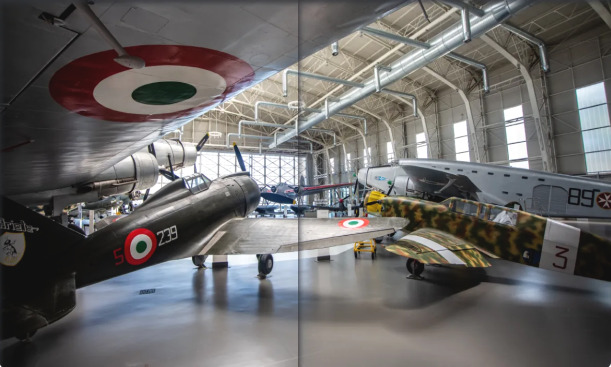- YES!
- NO:(
History:
In 1933, Luigi Nardi, together with his brothers Elio and Edoardo and with the support of industrialist Carlo Borrani, initiated a project to design a single-engine trainer aircraft with retractable landing gear, an innovative solution for the time. The project, presented to the Regia Aeronautica, received funding for static tests. Construction took place in a small workshop in Milan, where about ten technicians worked on the design and production.
The first prototype, called FN.305, was completed in 1935. Equipped with a Fiat A.70 radial engine delivering 185 HP, the aircraft successfully performed its maiden flight in Bresso, piloted by Arturo Ferrarin. The prototype stood out for its retractable landing gear, innovative compared to Italian standards. During testing, it demonstrated excellent performance but sustained damage in an emergency landing.
The project gained attention, partly due to the Regia Aeronautica’s support and interest in the retractable landing gear. The FN.305 was exhibited at the 1st International Aeronautical Exhibition in Milan in 1935, attracting attention for its advanced features. The final production version included the Alfa Romeo 115 engine, and an armed version.
The brothers made decided to sell the patent to Piaggio to achieve a bigger production.
The first prototype of the FN.305 with the Alfa Romeo 115 engine for the Regia Aeronautica was tested by Zappetta in Bresso. Piaggio produced 50 units of the first series (MM.50412–50461), available as either single-seat with an open cockpit or two-seater with a closed cockpit. The latter featured a more traditional canopy, differing from the distinctive Nardi solution.
On August 24, 1937, issues were reported during the II Avio Raduno del Littorio. Captain Fargnoli noted brake inefficiencies, uncomfortable actuation, cable failures, poor landing gear elasticity, flap control issues, and a broken window slider. Captain Bianchi also highlighted similar problems. These issues led to a meeting on September 13 to evaluate the faults, with a report expected by September 15. Special telephone intercepts revealed that Piaggio executives themselves were aware of the aircraft’s mediocre construction but attributed issues to modifications requested by the Regia Aeronautica.
Despite these concerns, the FN.305 impressed foreign delegations, resulting in export orders: 9 units for Chile and 31 for Romania. However, Romanian aircraft faced performance issues due to the heavier duralumin fuel tanks. On January 29, 1938, retractable landing gear mechanisms were deemed unreliable, leading to restrictions on flying with the gear extended until modifications were made.
By August 1938, the Regia Aeronautica had 33 FN.305s in service. These were distributed across various regions, with assignments to observation squadrons to familiarize pilots with monoplane and retractable landing gear aircraft as they transitioned from older Ro.37 bis to Ca.311 models. However, three fatal accidents during acrobatics prompted a thorough evaluation of the FN.305’s capabilities. By the end of August 1938, it remained in limited service, notably supporting pilot training and observation roles, despite challenges in fleet numbers and performance reliability.
General characteristics:
Wing
- Trapezoidal wing in three parts:
- Central section: Tubular steel structure connected to the fuselage.
- Outer sections: Wood structure with paired spars, plywood sheathing, and covering.
- Control surfaces: Ailerons and flaps made of wood, covered with plywood.
Tailplane
- Braced tailplanes with struts and ties.
- Structure: Wood with plywood covering.
- Horizontal stabilizer incidence: Adjustable.
Landing Gear
- Retractable landing gear:
- Retraction mechanism: Inward rotation with total retraction.
- Operation: Mechanical actuation.
- Tail skid: Shock-absorbing.
Fuselage
- Cross-section: Rectangular.
- Structure: Steel tubular frame welded with autogenous welding.
- Covering: Metal sheet around the engine and propeller; fabric on the remaining parts.
- Fuel tanks:
- Primary tank: 71 liters.
- Additional tanks: Two 50-liter tanks in each wing, total capacity 171 liters.
Cockpit
- Tandem seating with an enclosed cockpit:
- Canopy: Hinged on the right side, jettisonable in emergencies.
Instrumentation
- Main instrumentation (front cockpit):
- Anemometer.
- Variometer.
- Altimeter.
- Turn and bank indicator.
- Compass.
- Clock.
- Tachometers.
- Fuel pressure gauge.
- Oil pressure gauge.
- Dual oil temperature gauge.
- Ignition switch.
- Fire warning system.
Specifications
- Engine: Alfa Romeo 115
- Propeller: Two-bladed metal propeller with in-flight variable pitch.
- Power: 200 HP
- Wingspan: 8.47 m
- Total length: 7.00 m
- Total height: 2.10 m
- Wing area: 12.00 m²
- Empty weight: 540 kg
- Maximum weight: 840 kg
- Maximum speed: 340 km/h
- Minimum speed: 85 km/h
- Climb time: 9’ 18" to 3,000 m
- Maximum ceiling: 6,000 m
- Range: 1,100 km
- Takeoff distance: 312 m
- Landing distance: 330 m
- Crew: 2 (student and instructor)
Armament
2 x 7.7 mm Breda-SAFAT machine guns, in the engine cover, shooting trough the prop
Sources
Nardi FN.305 - Wikipedia
Italian Aircraft of WWII: Nardi F.N.305A
Dimensione Cielo- Scuola Collegamento vol.10
Its place in the current techtree acording to me:

















